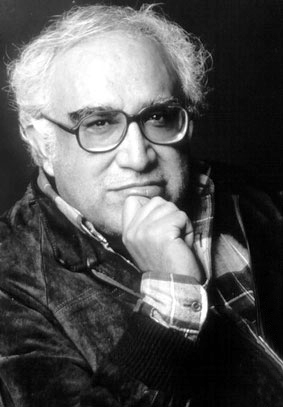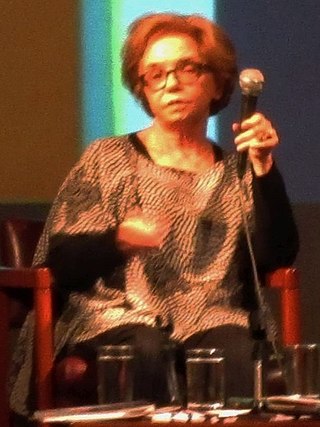
Carlos Monsiváis Aceves was a Mexican philosopher, writer, critic, political activist, and journalist. He also wrote political opinion columns in leading newspapers within the country's progressive sectors. His generation of writers includes Elena Poniatowska, José Emilio Pacheco, and Carlos Fuentes. Monsiváis won more than 33 awards, including the 1986 Jorge Cuesta Prize, the 1989 Mazatlán Prize, and the 1996 Xavier Villaurrutia Award. Considered a leading intellectual of his time, Monsiváis documented contemporary Mexican themes, values, class struggles, and societal change in his essays, books and opinion pieces. He was a staunch critic of the long-ruling Partido Revolucionario Institucional (PRI), leaned towards the left-wing, and was ubiquitous in disseminating his views on radio and television. As a founding member of "Gatos Olvidados", Monsiváis wanted his and other "forgotten cats" to be provided for beyond his lifetime.

Manuel Felguérez Barra was a Mexican abstract artist, part of the Generación de la Ruptura that broke with the muralist movement of Diego Rivera and others in the mid 20th century.

The Palace of the Marquis del Apartado is a historic residence located in Mexico City, just to the northeast of the city's Zocalo in the Historic center of Mexico City.

Cárteles Unidos, also known as La Resistencia is a Mexican criminal enforcer squad composed of well-trained gunmen from the Sinaloa Cartel, Gulf Cartel, La Familia Michoacana, and Knights Templar Cartel originally formed to expel the Los Zetas Cartel from the states of Michoacán and Jalisco. However, Cárteles Unidos' current main rival has now become the Jalisco New Generation Cartel; a paramilitary criminal organization based in the neighboring state of Jalisco.
Juan Manuel De la Rosa is a painter, engraver, and ceramicist known for his works on handmade paper. He studied lesser-known techniques for painting and papermaking from Japan, Egypt, Fiji, and France; his handmade paper is typically made of linen, cotton, or hemp. With these traditional approaches, he creates layers and adds new dimensions to his artworks.

Jazzamoart is a Mexican artist best known for his painting which is mostly connected to jazz music in some way. Born Francisco Javier Vázques Estupiñán in Irapuato, Guanajuato, his talent was recognized early and he took his professional name from his dual passions of jazz and art. He is best known as a painter with over 400 individual and collective exhibitions on several continents, but he has also done monumental sculpture, stage scenery and has collaborated with musicians. He lives in Mexico City.
Gustavo Arias Murueta was a Mexican painter, sculptor and poet, a member of the Salón de la Plástica Mexicana best known for his work in drawing, graphic arts and oil painting. He originally studied architecture at the Universidad Nacional Autónoma de México where he met artists such as Rufino Tamayo, David Alfaro Siqueiros and José Clemente Orozco. In the 1950s, he began to produce artworks, with his first exhibition in 1961. From then until his death he had a career as an artist with individual and collective exhibitions in both Mexico and abroad. While his work had been heavily influenced by Orozco, he was considered part of the Generación de la Ruptura movement.
Olga Dondé was a Mexican artist involved in various fields but best known her still life pieces. She was a self-taught painter, who worked for two years until she decided to enter works in a show in 1968. From then she had about 100 showings of her work, including more than forty individual exhibitions in Mexico, the United States, South Americana and Europe. She also founded artistic organizations, an art gallery and a publishing house. Dondé’s work was recognized by admission in the Salón de la Plástica Mexicana, among other honors and her work continues to be shown and honored after her death.

Naomi Siegmann was an American artist who developed her career in Mexico, and was noted for her depiction of everyday objects outside their normal contexts. She began her career after she moved to Mexico with her family, learning to carve wood. She worked in this medium for about twenty years, before moving on to other materials, including recycled ones, in part due to her concerns for the environment. During her career, she had solo exhibits in Mexico and the United States, with participation in collective exhibits in these countries and Europe. She has been commissioned to create monumental works in Mexico and the United States. Her work has been recognized through membership in the Salón de la Plástica Mexicana.
Teresa del Conde Pontones was a Mexican art critic and art historian.

Fanny Sanín Sader is a Colombian born artist from Bogotá who resides in New York City. The daughter of Gabriel Sanín Tobón and Fanny Sader Guerra, she is best known for her paintings of abstract geometric forms and colors. She is considered to be part of the second generation of abstract artists from Colombia.

Irene Zundel, is a Mexican sculptor, painter and photographer. Her sculpture is made of different materials and has been shown around the world. Zundel lives and works in Mexico City.
Marta Palau Bosch was a Spanish-Mexican artist who resided in Mexico. She worked in engraving, painting, sculpture, and most prominently in tapestries, defining herself by her profound artistic use and arrangement of native Mexican natural materials. She was one of the first Mexican artists to focus on themes around women's and immigrants' experiences during the 1970s, especially in her Ilerda series of tapestries and later with her Nahual sculptures.

The Young Woman of Amajac is a pre-Hispanic sculpture depicting an indigenous woman. It was discovered by farmers in January 2021 in the Huasteca region, in eastern Mexico.

Árbol adentro is an outdoor sculpture by José Fors, installed in Centro, Guadalajara, in the Mexican state of Jalisco.

Inmolación de Quetzalcóatl is a fountain and sculpture by Victor Manuel Contreras, installed in Plaza Tapatía, in Centro, Guadalajara, in the Mexican state of Jalisco.

Rickshaws are used in Mexico City, primarily for the transportation of citizens and tourists. Otherwise known in Spanish as bicitaxis, ciclotaxis, golfitaxis, mototaxis or tricitaxis, they can be either human-powered or engine-powered transports. They are regulated by the Secretariat of Mobility of the city.

The Puerta de los Leones is the main entrance to the first section of the Chapultepec Park, in Mexico City. It is found near Paseo de la Reforma and it connects with Calzada Juventud Heroica. It was created by Antonio Muñoz García.

The Fuente de la República is a carbon steel fountain and sculpture installed in Mexico City, Mexico. It was inaugurated on 13 December 2007 by Marcelo Ebrard, the Federal District's head of government, and was placed at the intersection of Avenida Paseo de la Reforma, Avenida Juárez and Avenida Bucareli, in the Cuauhtémoc borough. The fountain was created specifically for the celebrations of the 200th anniversary of the country's independence in 2010. It was designed by Manuel Felguérez, who also designed the Puerta 1808 sculpture found in front of it.















